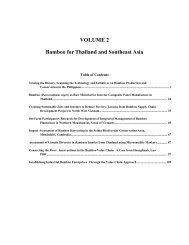WBC-VIII-Vol.4 – Resources – Forestry, Plantations and ... - BambuSC
WBC-VIII-Vol.4 – Resources – Forestry, Plantations and ... - BambuSC
WBC-VIII-Vol.4 – Resources – Forestry, Plantations and ... - BambuSC
Create successful ePaper yourself
Turn your PDF publications into a flip-book with our unique Google optimized e-Paper software.
Abstract<br />
Integrated Management of Bamboo <strong>Resources</strong><br />
in the Colombia Coffee Region<br />
J.C. Camargo 1 ; M.A. Dossman 2 ; A. Rodriguez 2 ;L.M. Arias 2<br />
1 Associated Professor, Technological University of Pereira, Colombia<br />
2 Researcher, Technological University of Pereira, Colombia <strong>and</strong> CIEBREG<br />
The silvicultural management <strong>and</strong> planning of guadua bamboo forests as well as their capability of providing<br />
environmental services are analysed in this work. In these sense, the bases for inventory <strong>and</strong> mensuration are<br />
defined as the best way of procuring adequate information. Because of differences on growth <strong>and</strong> management,<br />
silviculture is separately discussed for natural st<strong>and</strong>s <strong>and</strong> plantations. In addition, an approach to define the<br />
effect of site conditions on guadua productivity <strong>and</strong> quality is proposed. Furthermore, benefits of guadua forest<br />
referred to carbon sequestration <strong>and</strong> soils restoration are remarked. Finally, information was integrated to define<br />
the capability of l<strong>and</strong> for guadua production <strong>and</strong> units of forest management (UFM), which are an instrument<br />
that government institutions use for forest planning. Silvicultural practices on natural st<strong>and</strong>s are specially<br />
focused to harvesting, thus the possibilities of an adequate management depend on a proper definition of harvest<br />
intensity <strong>and</strong> harvest frequency. For guadua plantations, results on dynamics reveal the significant consequence<br />
of fertilisation <strong>and</strong> weed control, specifically on growth <strong>and</strong> mortality of culms. As a contribution to elucidate<br />
the worth of guadua forest providing environmental services in the coffee region of Colombia, carbon<br />
sequestration <strong>and</strong> soil protection was assessed <strong>and</strong> quantified. Values up to 900 Tn ha -1 of total carbon stock<br />
were evidence for guadua st<strong>and</strong>s. Comparisons of soils properties among different l<strong>and</strong> covers evidenced better<br />
conditions in soils under guadua st<strong>and</strong>s even under those located on marginal areas. By using geographic<br />
information systems <strong>and</strong> software for modelling productivity of guadua st<strong>and</strong>s, information was integrated <strong>and</strong><br />
UFM defined. Besides guadua plantations were successfully used in processes of soil restoration, reducing<br />
significantly soil erosion. Silvicultural practices, forest planning <strong>and</strong> the quantification of environmental<br />
services, give the bases for an integrated management of this bamboo forest in the coffee region of Colombia.<br />
Introduction<br />
In the Colombian coffee region the woody bamboo species guadua (Guadua angustifolia Kunth) represents an<br />
important natural resource traditionally used by farmers for many purposes such as construction, furniture <strong>and</strong><br />
h<strong>and</strong>icrafts (Londoño 1998). Due to the variety of uses the commercial value of guadua culms has recently<br />
increased (Held 2005). Therefore, this resource has potential productive <strong>and</strong> protective functions essential for<br />
the sustainable development of this important region of Colombia (Camargo 2006).The species guadua has its<br />
natural habitat in Colombia, Ecuador, <strong>and</strong> Venezuela, but it has also been introduced to other countries in<br />
Central <strong>and</strong> South America, Europe <strong>and</strong> Asia. Its culms are an ideal construction material with a high percentage<br />
<strong>VIII</strong> World Bamboo Congress Proceedings Vol 4-34




